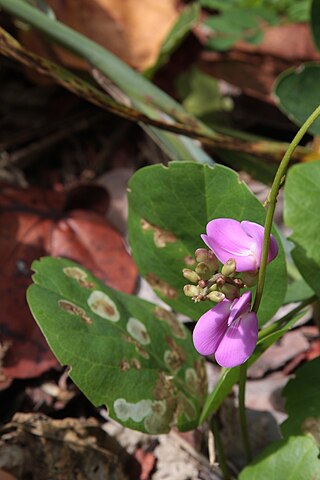
Lapageria is a genus of flowering plants with only one known species, Lapageria rosea, commonly known as Chilean bellflower or copihue. Lapageria rosea is endemic to Chile and it is the national flower of this country. It grows in forests in the southern part of Chile, being part of the Valdivian temperate rainforests ecoregion flora.

Alcea is a genus of over 80 species of flowering plants in the mallow family Malvaceae, commonly known as the hollyhocks. They are native to Asia and Europe. The single species of hollyhock from the Americas, the streambank wild hollyhock, belongs to a different genus.

Rhodiola rosea is a perennial flowering plant in the family Crassulaceae. It grows naturally in wild Arctic regions of Europe, Asia, and North America, and can be propagated as a groundcover.

Clusia is the type genus of the plant family Clusiaceae. Comprising 300-400 species, it is native to the Neotropics. The genus is named by Carl Linnaeus in honor of the botanist Carolus Clusius.

Albizia julibrissin, the Persian silk tree, pink silk tree, or mimosa tree, is a species of tree in the family Fabaceae, native to southwestern Asia and eastern Asia.

Alcea rosea, the common hollyhock, is an ornamental dicot flowering plant in the family Malvaceae. It was imported into Europe from southwestern China during, or possibly before, the 15th century. William Turner, a herbalist of the time, gave it the name "holyoke" from which the English name derives.
Clonostachys rosea f. rosea, also known as Gliocladium roseum, is a species of fungus in the family Bionectriaceae. It colonizes living plants as an endophyte, digests material in soil as a saprophyte and is also known as a parasite of other fungi and of nematodes. It produces a wide range of volatile organic compounds which are toxic to organisms including other fungi, bacteria, and insects, and is of interest as a biological pest control agent.

Sarracenia rosea is a species of pitcher plant in the genus Sarracenia and is sometimes known as Burk's southern pitcher plant.

Coreopsis rosea is a North American species of Coreopsis in the family Asteraceae. It has a discontinuous distribution in the eastern United States and Canada, found in Nova Scotia, Massachusetts, Rhode Island, New York, New Jersey, Pennsylvania, Delaware, Maryland, Georgia, and South Carolina.

Antennaria rosea is a North American species of flowering plant in the family Asteraceae known by the common name rosy pussytoes. Other common names include cat's foot and mountain everlasting. The second part of its scientific name, rosea, is Latin for pink. It is widespread across much of Canada including all three Arctic territories, as well as Greenland, the western and north-central United States, and the Mexican state of Baja California.

Canavalia rosea is a species of flowering plant of the genus Canavalia in the pea family of Fabaceae, it has a pantropical and subtropical distribution in upper beaches, cliffs, and dunes. Common names include beach bean, bay bean, sea bean, greater sea bean, seaside jack-bean, coastal jack-bean, and MacKenzie bean.

Tephrosia rosea, commonly known as Flinders River poison, is a plant species, endemic to northern Australia. It is a shrub with an erect or sprawling habit, growing to between 0.2 and 2 metres high. Pink to purple flowers are produced throughout the year in the species' native range.

Clusia rosea, the autograph tree, copey, cupey, balsam apple, pitch-apple, and Scotch attorney, is a tropical and sub-tropical flowering plant species in the family Clusiaceae. The name Clusia major is sometimes misapplied to this species.
Armatimonadota is a phylum of gram-negative bacteria.

Zephyranthes rosea, commonly known as the Cuban zephyrlily, rosy rain lily, rose fairy lily, rose zephyr lily or the pink rain lily, is a species of rain lily native to Peru and Colombia. They are widely cultivated as ornamentals and have become naturalized in tropical regions worldwide. Like all rain lilies, they are known for blooming only after heavy rains.

Margaretta is a genus of plants in the family Apocynaceae first described as a genus in 1875. A dozen names have been proposed as species within Margaretta, but at present only one, Margaretta rosea, is categorized as "accepted" by The Plant List. Most of the rest are "unresolved," in other words, of uncertain affinity. Margaretta rosea is native to Uganda in eastern Africa.

Carex rosea, the rosy sedge, is a flowering plant and part of the family Cyperaceae. Synonyms for Carex rosea include Carex concoluta, and Carex flaccidula. It is native to central and eastern North America and it exists in wet to dry soils. Carex rosea can be found in shores of streams and bottomlands, as well as ponds. It is known to have good adaptations to dry-shade locations. It is an evergreen plant which is easy to grow.














